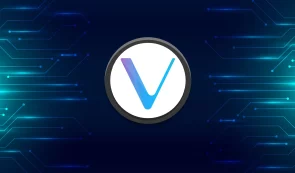What is VeChain
VeChain is a tier-one smart contract platform that allows businesses to create and manage decentralized applications (dApps).
VeChain’s primary goal is to provide new tools for efficient data transfer and supply chain management.
History of VeChain
VeChain was founded in 2015 by Sunny Lu, former Chief Information Officer (CIO) of Louis Vuitton’s China branch. The project started as a subsidiary of Bitse, one of the largest Chinese blockchain companies.
Originally based on Ethereum, the VeChain (VEN) protocol rebranded to VeChain Thor (VET) with the launch of its own blockchain in 2018, increasing the scope of decentralized applications to include more general data solutions.
VEN was replaced with VET at a 1:1,000 ratio.
How does VeChain work?
VeChain uses the consensus Proof-of-Authority (PоА) protocol. Transactions and new blocks are validated by the user using their pledge identity. Endorsers earn their position through their reputation and are therefore incentivized to maintain the transaction process to maintain that reputation.
Identity disclosure is a prerequisite for VET token holders who want to become validators. Unlike proof of stake (PoW), PoA is not energy intensive and does not require a minimum number of validators to reach a consensus, which contributes to the relatively high transaction speed.
One hundred one master nodes are responsible for achieving consensus on transactions in the VeChain blockchain.
VeChain network has two types of master nodes, with the economic master node being one of them. Unlike the other type, this node is not involved in producing blocks or ledger entries but rather in power verification. Each economic master node is allocated votes proportional to their VET token holdings, with every 10,000 VET tokens giving one vote. Becoming an economic master node requires passing KYC verification and pledging a minimum of 25 million VET tokens.
VeChain’s team aims to find a balance between centralization and decentralization by implementing these different master node types.
VeChain aims to allow every company to launch new types of dApps.
To make it easier to create dApps, the VeChain team built a component called VeChain ToolChain, a software development kit (SDK).
Two-token design
To make the project software work, VeChain uses two tokens: the VET and the VTHO. While VET is used to store and transfer value, VTHO is used for transaction operations in the blockchain.
This design aims to isolate the volatility of the VET coin price from the cost of computing on the network, allowing applications on VeChain to charge stable fees (since the supply of VTHOR can be adjusted to maintain a stable price for transactions).
Like the Ethereum blockchain uses ETH and gas, miners earn fees in VTHO for the computations processed by the network. The more complex the calculation, the more VTHO a program will require.
Nodes that stack VET tokens get a vote on network improvements and are rewarded with VTHO on each block.
How can VeChain be used?
One instance where the VeChain system demonstrates its value is in its ability to monitor various aspects such as quality, authenticity, storage temperature, transport environment, and more. This level of oversight spans from the production site to the eventual delivery of the product to the consumer.
VeChain achieves this feat by integrating smart chips, radio frequency identification (RFID) tags, and sensors, which transmit pertinent data through the blockchain network. This feature enables authorized stakeholders to access the information in real time.
To illustrate further, car owners could leverage the VeChain platform to gain ownership of their data, which could help them secure more favorable policies and terms from their insurance providers.
Corporations using the VeChain blockchain platform include:
- PricewaterhouseCoopers: The accounting giant has partnered with VeChain to offer blockchain solutions to its clients.
- BMW: The automaker is using VeChain to prevent odometer fraud when selling cars
- LVMH: Luxury brand manufacturer uses VeChain to track luxury leather goods
- Walmart: The retail store chain uses VeChain to track food provenance.
